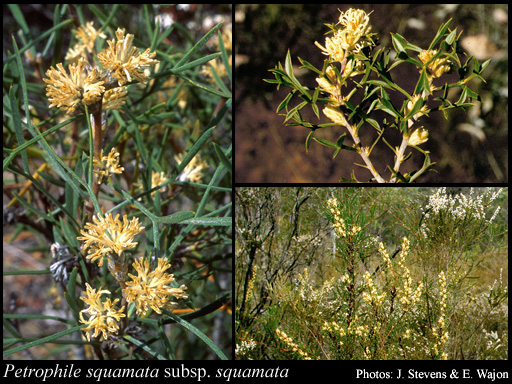- Conservation Code
- Not threatened
- Naturalised Status
- Native to Western Australia
- Name Status
- Current
Shrub, 0.3-2 m high. Fl. yellow-cream-white, Jul to Dec. Clayey & sandy soils, often gravelly over laterite or granite. Winter-wet flats & swamps.

Scientific Description
Shrubs, 0.5-2 m high; branchlets hairy, with straight hairs. Leaves alternate, 20-40 mm long, glabrous; lamina flat, once divided or twice or more divided, pinnately divided or tripartitely divided, divided to the midrib, with (3-)14-21(-23) points or lobes; distance from base of leaf to lowest lobe 5-15 mm. Inflorescences not viscid, cream or yellow. Perianth 8-11.5 mm long, hairy, the limb apex hairy all over; pistil 9-12 mm long; pollen presenter not fusiform, glabrous, 3-4 mm long, the brush 2-2.3 mm long. Cone with persistent scales, 10-16 mm long. Flowers in June, July, August, September, October, November or December. Occurs in the South-west (SW) Botanical Province(s), in the Swan Coastal Plain (SWA), Avon Wheatbelt (AW), Jarrah Forest (JF), Mallee (MAL), Warren (WAR) or Esperance Plains (ESP) IBRA subregion(s).
Distribution
- IBRA Regions
- Avon Wheatbelt, Esperance Plains, Jarrah Forest, Mallee, Swan Coastal Plain, Warren.
- IBRA Subregions
- Fitzgerald, Katanning, Northern Jarrah Forest, Perth, Southern Jarrah Forest, Warren, Western Mallee.
- IMCRA Regions
- WA South Coast.
- Local Government Areas (LGAs)
- Albany, Augusta Margaret River, Boddington, Boyup Brook, Broomehill-Tambellup, Busselton, Cranbrook, Denmark, Gnowangerup, Harvey, Jerramungup, Kent, Murray, Nannup, Narrogin, Plantagenet, Wagin, West Arthur, Woodanilling.